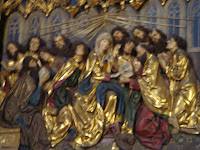This weekend I was privileged to do all of that. Friday afternoon I journeyed to the Sisters of Notre Dame Motherhouse to "scout" out the route before actually having Mass on Sunday morning. I took the 32 bus to the 911 bus and got off at the Notre Dame stop. So much for traveling incognito. Two of the Indonesian nuns were also traveling on the bus and the "caught" me. I got invited in for a cup of coffee and we enjoyed laughing about their discovery of me sharing the same bus with them.
 Saturday I left the Casa O'Toole and trekked all through Rome. My first stop was a beautiful museum called the Doria Pamphilii. This gorgeous place was given to Pope Innocent X's nephew when he appointed him a cardinal. You've undoubtedly heard the word "nepotism." The word comes from the Italian word nepotismo which is based on the Latin word nepos meaning nephew or grandson. Since the clergy were celibate, they would often bestow special favors on their nephews, as was in the case of the Pamphilii palace. Innocent's nephew, however, ended up marrying, giving up his position and collecting massive amounts of art. He married into the Doria family, thus producing the "Doria Pamphilii" palace and wanting everyone to know him as a major patron of the arts. Even the wallpaper here was considered rare and valuable. In rooms without fabric wallcovering, he'd utilize paintings as a sort of wallpaper.
Saturday I left the Casa O'Toole and trekked all through Rome. My first stop was a beautiful museum called the Doria Pamphilii. This gorgeous place was given to Pope Innocent X's nephew when he appointed him a cardinal. You've undoubtedly heard the word "nepotism." The word comes from the Italian word nepotismo which is based on the Latin word nepos meaning nephew or grandson. Since the clergy were celibate, they would often bestow special favors on their nephews, as was in the case of the Pamphilii palace. Innocent's nephew, however, ended up marrying, giving up his position and collecting massive amounts of art. He married into the Doria family, thus producing the "Doria Pamphilii" palace and wanting everyone to know him as a major patron of the arts. Even the wallpaper here was considered rare and valuable. In rooms without fabric wallcovering, he'd utilize paintings as a sort of wallpaper.
One painting which struck me was called, the Sacrifice of Isaac, by Pasquale Chiesa. It was painted in 1666 and features the gnarled hand of Abraham, knife in hand, just about to enter into Isaac. You can sense the danger, the fear, the trepidation, and the doubt as Abraham peers into heaven to hope for God's relent. The interesting thing is that no one has ever heard about this artist yet his brilliance is recognized in this magnificent piece.
Later I visited the Church of San Marcello al Corso. This church on the Via del Corso was a simpler church yet stunningly beautiful as well. Though it suffered almost total destruction in the year, a crucifix was left completely untouched. This was considered a miracle and, to this day, the cross is venerated and prayed before because of what had occurred.
 On Sunday after Mass with the Sisters of Notre Dame I wandered to St. Peter in Chains, near the Roman Colloseum. A reliquary near the sanctuary displays a set of chains supposedly used to bind the hands and feet of St. Peter before his crucifixion. But the most visited spot in the church is the sculpture of Moses carved by Michelangelo commissioned by Pope Julius II for his tomb. He is 8
On Sunday after Mass with the Sisters of Notre Dame I wandered to St. Peter in Chains, near the Roman Colloseum. A reliquary near the sanctuary displays a set of chains supposedly used to bind the hands and feet of St. Peter before his crucifixion. But the most visited spot in the church is the sculpture of Moses carved by Michelangelo commissioned by Pope Julius II for his tomb. He is 8 feet tall sitting down, wearing a beautiful garment, filled with power and energy. He looks as if he's about to stand, with left leg pushed back and commandments in hand. His anger and fury are evident because, when he came down from Mt. Sinai, he finds the Israelites unfaithful. Even in his beard there is energy and velocity creating rich shadows and alternations between dark and light and even textures. Michelangelo wanted the tomb to be filled with carved figures but, unfortunately, he was unable to accomplish his vision. However, the Moses is breathtaking and certainly conveys a powerful message to visitors even today, more than 500 years later.












































